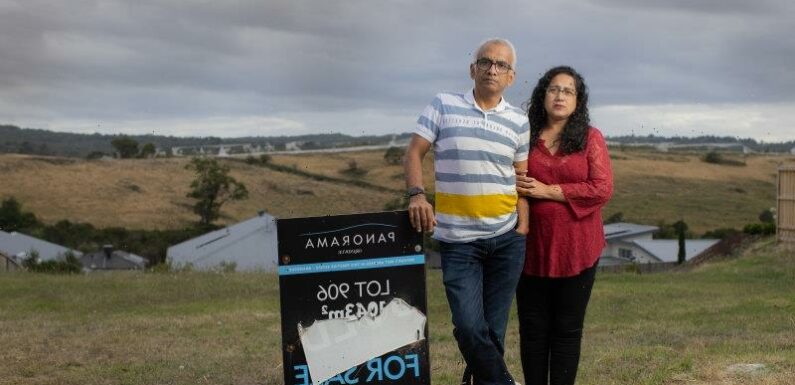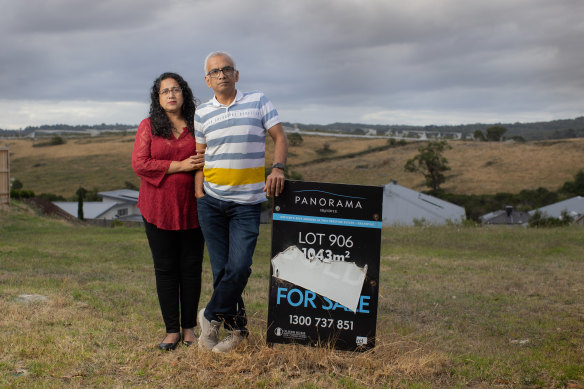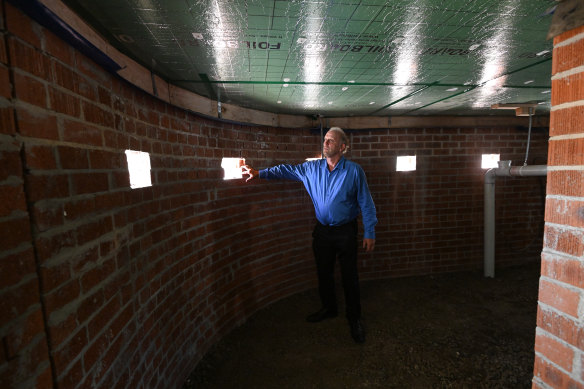
Sushant and Anamica Chakravarty transferred more than $78,000 last year to build their dream home in Officer, an emerging suburb in Melbourne’s south-east.
Ten years after arriving in Australia from India, the construction of this five-bedroom property was going to be a symbol of their family’s success.
Anamica and Sushant Chakravarty on their property where they planned to build a dream home.Credit:Simon Schluter
To construct the $1.5 million property, they chose Hallbury Homes, a small company branded as a luxury builder with an impressive display home in Langwarrin.
“I thought we’d picked the best,” Sushant says.
But less than five weeks after the final payment was transferred, the company went into voluntary administration, leaving the Chakravartys with only a grassy block and no sense of what would come next.
The couple were among at least 40 would-be homeowners left “high and dry” when the company appointed administrators on January 5.
Corporate filings show the company owes $8 million to 401 creditors, including contractors and homeowners around Melbourne who have been left with partially built properties, some that are riddled with defects including cracked walls, uneven surfaces and mould.
The collapse of Hallbury Homes highlights pressures in Australia’s construction industry, following crises at major firms ProBuild and Metricon, but also raises questions about the effectiveness of the Victorian Building Authority (VBA).
“I called up the VBA months ago and told them something was not right,” says another homeowner Terry Conder, who has been working with Hallbury for six years. “They did an inspection, but then nothing. It’s been a nightmare.”
Terry Conder has been left with a part-built home after Hallbury went under. Credit:Joe Armao
During a three-hour meeting on Thursday, that became “heated”, according to those in attendance, creditors voted to push the company into liquidation. Now, Menzies Advisory principal Michael Caspaney will have greater powers to investigate a range of issues, including whether the company traded while insolvent – where debts are accrued that directors know can’t be paid.
“I’ve always had a problem with builders who are trying to do business beyond their means,” Caspaney said. “The government of the day doesn’t want to be seen to be stifling builders, so there’s very few financial checkpoints. Now the creditors have put it into liquidation, that gives me the full power to investigate.”
According to corporate filings, Caspaney estimated that any claim for insolvent trading might be worth $6 million.
Hallbury director Glenn Smith strongly denies these allegations. He says the investigation will eventually clear him of wrongdoing. While he concedes problems were mounting for more than a year, he contends it was a change in a critical concrete contract that tipped the company over the edge after he and business partner Cliff Hall put everything into keeping the operation afloat, including borrowing from friends and family.
“With every building collapse, the directors are turned into villains,” Smith says. “There’s a lot of people with heat, making up crazy allegations that are frankly offensive.”
He blames the former Coalition government’s Home Builders policy, introduced during the first year of the coronavirus pandemic to support the economy through subsidising residential renovation work. “That gave $2.1 billion stimulus to an industry that didn’t need stimulating,” Smith says.
With many of its building contracts fixed, Smith says his company was unable to keep up with the rising cost of materials. “We ran out of money. We’ve put blood, sweat, everything [into it], and it just wasn’t enough,” he says.
For the homeowners, the reasons for the collapse do not change the losses they are facing. Two of those homeowners, Adam Van Haeften and his partner, signed a contract with Hallbury in February 2020, but soon noticed a high turnover of contractors and requiring payment for works before the couple were able to inspect the site.
With every building collapse, the directors are turned into villains
“Building is never easy. It’s challenging. We designed a beautiful house. It was a knock-down rebuild,” Van Haeften said. “At the end of the day, we feel they have short-changed us. They asked us to pay for work they hadn’t completed.”
Van Haeften hired building consultant Darbecca to examine whether the Balwyn North site complied with building standards. It produced a 65-page report listing “items that, in our judgement, do not reach an acceptable standard of quality, level of building practice or have not been built in a proper or workmanlike manner.”
Van Haeften estimates it will cost about $550,000 to complete the works, and his builders’ insurance is set to expire within weeks, so the race is on.
“We’ve just got to move forward. The longer it sits there, it makes it harder to find a builder. There’s going to be a flurry of activity with homeowners finding builders, and signing them up, so we can finish the work,” he says.
As for the Chakravartys, they feel let down by the system that allowed this to happen.
“We have struggled to save this money for 10 years. We feel so cheated, it’s really taking a toll on us,” Sushant says. “We never thought that in Australia, in a country where … [there are] regulators, this can happen. This has happened in this country.”
Patrick Elligett sends an exclusive newsletter to subscribers each week. Sign up to receive his Note from the Editor.
Most Viewed in National
From our partners
Source: Read Full Article

